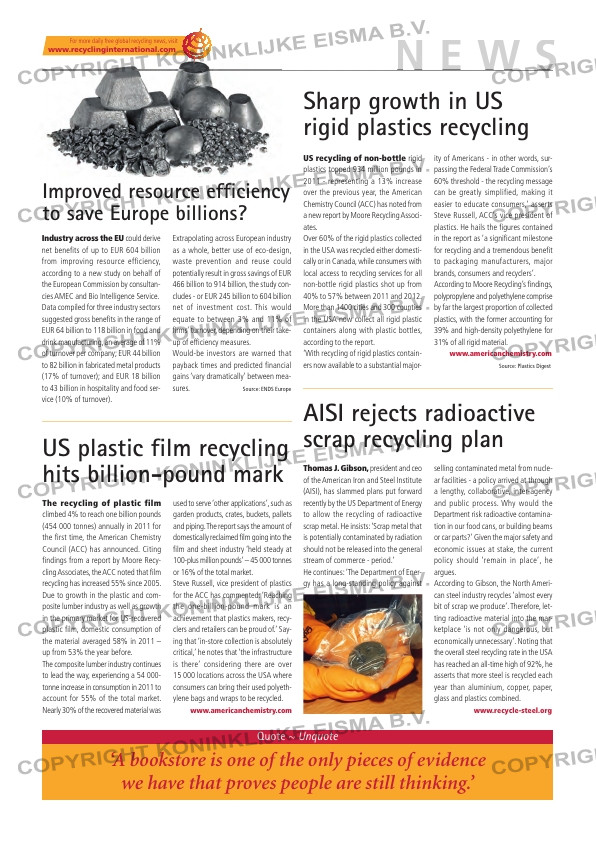Page 17 from: April 2013

N E W S
For more daily free global recycling news, visit
www.recyclinginternational.com
Quote ~ Unquote
‘A bookstore is one of the only pieces of evidence
we have that proves people are still thinking.’
The recycling of plastic film
climbed 4% to reach one billion pounds
(454 000 tonnes) annually in 2011 for
the fi rst time, the American Chemistry
Council (ACC) has announced. Citing
fi ndings from a report by Moore Recy-
cling Associates, the ACC noted that fi lm
recycling has increased 55% since 2005.
Due to growth in the plastic and com-
posite lumber industry as well as growth
in the primary market for US-recovered
plastic fi lm, domestic consumption of
the material averaged 58% in 2011 –
up from 53% the year before.
The composite lumber industry continues
to lead the way, experiencing a 54 000-
tonne increase in consumption in 2011 to
account for 55% of the total market.
Nearly 30% of the recovered material was
used to serve ‘other applications’, such as
garden products, crates, buckets, pallets
and piping. The report says the amount of
domestically reclaimed fi lm going into the
fi lm and sheet industry ‘held steady at
100-plus million pounds’ – 45 000 tonnes
or 16% of the total market.
Steve Russell, vice president of plastics
for the ACC has commented: ‘Reaching
the one-billion-pound mark is an
achievement that plastics makers, recy-
clers and retailers can be proud of.’ Say-
ing that ‘in-store collection is absolutely
critical,’ he notes that ‘the infrastructure
is there’ considering there are over
15 000 locations across the USA where
consumers can bring their used polyeth-
ylene bags and wraps to be recycled.
www.americanchemistry.com
US plastic film recycling
hits billion-pound mark
US recycling of non-bottle rigid
plastics topped 934 million pounds in
2011 – representing a 13% increase
over the previous year, the American
Chemistry Council (ACC) has noted from
a new report by Moore Recycling Associ-
ates.
Over 60% of the rigid plastics collected
in the USA was recycled either domesti-
cally or in Canada, while consumers with
local access to recycling services for all
non-bottle rigid plastics shot up from
40% to 57% between 2011 and 2012.
More than 1400 cities and 300 counties
in the USA now collect all rigid plastic
containers along with plastic bottles,
according to the report.
‘With recycling of rigid plastics contain-
ers now available to a substantial major-
ity of Americans – in other words, sur-
passing the Federal Trade Commission’s
60% threshold – the recycling message
can be greatly simplified, making it
easier to educate consumers,’ asserts
Steve Russell, ACC’s vice president of
plastics. He hails the fi gures contained
in the report as ‘a signifi cant milestone
for recycling and a tremendous benefi t
to packaging manufacturers, major
brands, consumers and recyclers’.
According to Moore Recycling’s fi ndings,
polypropylene and polyethylene comprise
by far the largest proportion of collected
plastics, with the former accounting for
39% and high-density polyethylene for
31% of all rigid material.
www.americanchemistry.com
Source: Plastics Digest
Sharp growth in US
rigid plastics recycling
Industry across the EU could derive
net benefi ts of up to EUR 604 billion
from improving resource efficiency,
according to a new study on behalf of
the European Commission by consultan-
cies AMEC and Bio Intelligence Service.
Data compiled for three industry sectors
suggested gross benefi ts in the range of
EUR 64 billion to 118 billion in food and
drink manufacturing, an average of 11%
of turnover per company; EUR 44 billion
to 82 billion in fabricated metal products
(17% of turnover); and EUR 18 billion
to 43 billion in hospitality and food ser-
vice (10% of turnover).
Extrapolating across European industry
as a whole, better use of eco-design,
waste prevention and reuse could
potentially result in gross savings of EUR
466 billion to 914 billion, the study con-
cludes – or EUR 245 billion to 604 billion
net of investment cost. This would
equate to between 3% and 11% of
fi rms’ turnover, depending on their take-
up of effi ciency measures.
Would-be investors are warned that
payback times and predicted fi nancial
gains ‘vary dramatically’ between mea-
sures. Source: ENDS Europe
Improved resource efficiency
to save Europe billions?
Thomas J. Gibson, president and ceo
of the American Iron and Steel Institute
(AISI), has slammed plans put forward
recently by the US Department of Energy
to allow the recycling of radioactive
scrap metal. He insists: ‘Scrap metal that
is potentially contaminated by radiation
should not be released into the general
stream of commerce – period.’
He continues: ‘The Department of Ener-
gy has a long-standing policy against
selling contaminated metal from nucle-
ar facilities – a policy arrived at through
a lengthy, collaborative, inter-agency
and public process. Why would the
Department risk radioactive contamina-
tion in our food cans, or building beams
or car parts?’ Given the major safety and
economic issues at stake, the current
policy should ‘remain in place’, he
argues.
According to Gibson, the North Ameri-
can steel industry recycles ‘almost every
bit of scrap we produce’. Therefore, let-
ting radioactive material into the mar-
ketplace ‘is not only dangerous, but
economically unnecessary’. Noting that
the overall steel recycling rate in the USA
has reached an all-time high of 92%, he
asserts that more steel is recycled each
year than aluminium, copper, paper,
glass and plastics combined.
www.recycle-steel.org
AISI rejects radioactive
scrap recycling plan
RI-3_NEWS.indd 17 08-04-13 09:22



